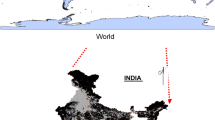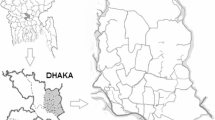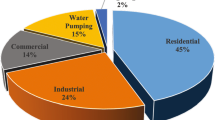Abstract
Electric power consumption (EPC) is one of the basic indices for evaluating electric power use. Obtaining timely and accurate data on the spatiotemporal dynamics of EPC is crucial for understanding and practical deployment of electric power resources. In this study, an EPC model was developed using stable nighttime lights time-series data from the Defense Meteorological Satellite Program Operational Linescan System (DMSP/OLS). The model was used to reconstruct the spatial patterns of EPC in Chinese Mainland at the county level from 1995 to 2008. In addition, the spatiotemporal dynamics of EPC were analyzed, and the following conclusions were drawn. (1) The EPC model reliably represented the spatiotemporal dynamics of EPC in Chinese Mainland with approximately 70% accuracy. (2) The EPC in most regions of Chinese Mainland was at low to moderate levels, with marked temporal and spatial variations; of high-level EPC, 58.26% was concentrated in eastern China. Six urban agglomerations (Beijing-Tianjin-Tangshan region, Shanghai-Nanjing-Hangzhou region, Pearl River Delta, Shandong Peninsula, middle-south of Liaoning Province, and Sichuan Basin) accounted for 10.69% of the total area of Chinese Mainland but consumed 39.23% of the electricity. (3) The EPC of most regions in Chinese Mainland increased from 1995 to 2008, and 64% of the mainland area showed a significant increase in EPC. Moderate increases in EPC were found in 61.62% of eastern China and 80.65% of central China from 1995 to 2008, whereas 75.69% of western China showed no significant increase in EPC. Meanwhile, 77.27%, 89.35%, and 66.72% of the Shanghai-Nanjing-Hangzhou region, Pearl River Delta, and Shandong Peninsula, respectively, showed high-speed increases in EPC. Moderate increases in EPC occurred in 71.12% and 72.13% of the Beijing-Tianjin-Tangshan region and middle-south of Liaoning Province, respectively, while no significant increase occurred in 56.34% of the Sichuan Basin.
Similar content being viewed by others
References
Chen Y, Li X, Chen J et al., 2002. The change of NDVI time series based on change vector analysis in China, 1983–1992. Journal of Remote Sensing, 6(1): 12–19. (in Chinese)
Doll C, Muller J, Elvidge C, 2000. Night-time imagery as a tool for global mapping of socioeconomic parameters and greenhouse gas emissions. Ambio, 29: 157–162.
Elvidge C, Baugh K, Kihn E et al., 1997a. Mapping city lights with nighttime data from the DMSP Operational Linescan System. Photogrammetric Engineering and Remote Sensing, 63: 727–734.
Elvidge C, Baugh K, Kihn E et al., 1997b. Relation between satellite observed visible-near infrared emissions, population, economic activity and electric power consumption. International Journal of Remote Sensing, 18: 1373–1379.
Elvidge C, Imhoff M, Baugh K et al., 2001. Night-time lights of the world: 1994–1995. ISPRS Journal of Photogrammetry & Remote Sensing, 56: 81–99.
Elvidge C, Ziskin D, Baugh K et al., 2009. A fifteen year record of global natural gas flaring derived from satellite data. Energies, 2(3): 595–622.
He C, Shi P, Li J et al., 2006. Restoring urbanization process in China in the 1990s by using non-radiance-calibrated DMSP/OLS nighttime light imagery and statistical data. Chinese Science Bulletin, 51(13): 1614–1620.
Jia R, Liu Y, 2003. China’s power structure and its spatial optimization. Resources Science, 25(4): 14–19. (in Chinese)
Kramer H, 1994. Observation of the Earth and Its Environment: Survey of Missions and Sensors. Berlin: Springer-Verlag, 44–51.
Li Y, Zhang J, Wang G et al., 2010. Application of a new grey model to city electricity demand forecasting. Modern Electric Power, 27(4): 13–16. (in Chinese)
Liang C H, 2010. The impact factors of power consumption of Chinese cities: Based on city-level panel data analysis. Shanghai Journal of Economics, 7: 22–30. (in Chinese)
Lin B, 2003. Electricity consumption and Chinese economic growth: The study based on production function. Management World, 11: 18–27. (in Chinese)
Lo C, 2001. Modeling the population of China using DMSP operational line-scan system nighttime data. Photogrammetric Engineering and Remote Sensing, 67: 1037–1047.
NSBC (National Statistics Bureau of China), 2009. China City Statistical Yearbook. Beijing: China Statistics Press. (in Chinese)
Silvana A, Gilberto C, Antonio M et al., 2005. Estimating population and energy consumption in Brazilian Amazonia using DMSP night-time satellite data. Computers, Environment and Urban Systems, 29: 179–195.
Song Y, Ma M, 2007. Study on vegetation cover change in Northwest China based on SPOT VEGETATION data. Journal of Desert Research, 27(1): 89–93. (in Chinese)
Wang H, Tian P, Jin P, 2005. Time-varying parameter co-integration relationship between electricity consumption and economic growth in China. Journal of North China Electric Power University, 32(4): 48–51. (in Chinese)
Wang P, 2005. Application study on multivariate linear regression to electricity consumption forecasting in China. Northeastern Electric Power Technology, 8: 16–18. (in Chinese)
Wu H, Yi J, 2007. Study on region electricity consumption and economic growth: Based on efficiency. Industrial Technology & Economy, 26(7): 31–36. (in Chinese)
Wu Y, Li J, 2009. A local spatial econometric study on relationship between electricity consumption and economic growth of Chinese provinces. Scientia Geographica Sinica, 29(1): 30–35. (in Chinese)
Xie P, Tan Z, Hou J et al., 2009. Analysis on dynamic relationship between urbanization and electricity consumption level in China. Power System Technology, 33(14): 72–77. (in Chinese)
Xu J, 1996. Mathematical Methods in Contemporary Geography, 2nd ed. Beijing: Higher Education Press, 40–41. (in Chinese)
Yao S, Chen Z, Zhu Y, 2006. The Urban Agglomerations of China. Anhui: Press of University of Science and Technology of China, 139–231. (in Chinese)
Zhang B, 2009. Scenario analyses of China’s energy and power use and carbon emission in 2020. Energy of China, 31(3): 27–31. (in Chinese)
Zhuo L, Li Q, Shi P et al., 2006. Identification and characteristics analysis of urban land expansion types in China in the 1990s using DMSP/OLS Data. Acta Geographica Sinica, 61(2): 169–178. (in Chinese)
Author information
Authors and Affiliations
Corresponding author
Additional information
Foundation: The National Basic Research Program of China, No.2010CB950901; National Natural Science Foundation of China, No.40971059
Author: He Chunyang (1975–), Ph.D and Associate Professor
Rights and permissions
About this article
Cite this article
He, C., Ma, Q., Li, T. et al. Spatiotemporal dynamics of electric power consumption in Chinese Mainland from 1995 to 2008 modeled using DMSP/OLS stable nighttime lights data. J. Geogr. Sci. 22, 125–136 (2012). https://doi.org/10.1007/s11442-012-0916-3
Received:
Accepted:
Published:
Issue Date:
DOI: https://doi.org/10.1007/s11442-012-0916-3




